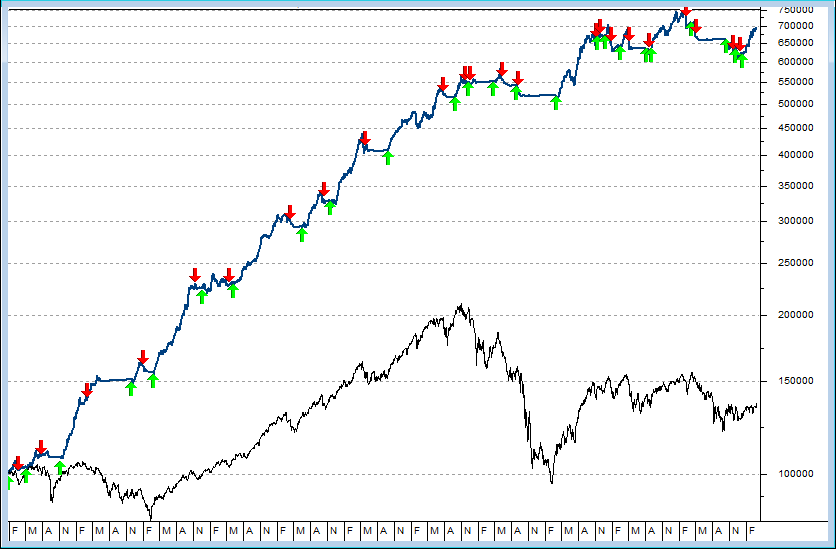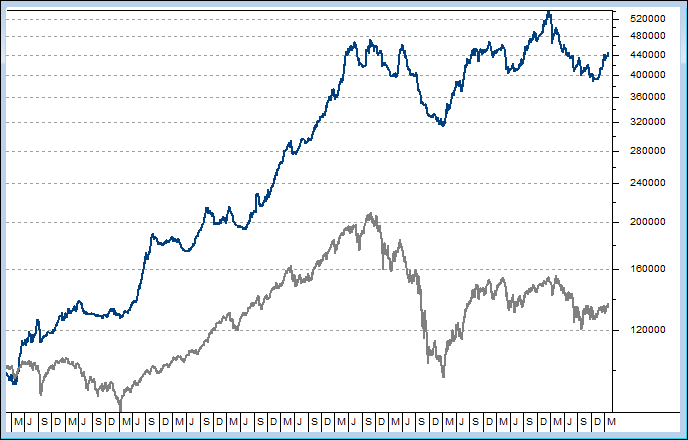Don’t forget to ‘Like’ us on Facebook – Click the ‘Like’ button on the right
In December 2011, after exhaustive research that took over 2000 man hours to complete, changes were publicly introduced to the SPA3 trading system. The revisions to SPA3 have now been implemented into a simulated and single historical portfolio that has been traded historically strictly according to the revised SPA3 rules and processes.
SPA3 Research
Before we review the SPA3 simulated performance, I first need you to understand a little about the journey. By highlighting the changes between the Pre-December 2011 and the Post-December 2011 SPA3 Edge my hope is that you’ll be able to understand how we have improved SPA3’s performance and that you might be able to take this information into the way you trade. Read the “Research White Paper”.
From the outset of our research there were two key objectives that we wanted to achieve:
- Increase portfolio returns, and
- Reduce drawdown.
To achieve these high level objectives key technical objectives were set and researched.
While a number of new concepts and principles were adopted from the research, none were found to be more effective than:
- The introduction of an adaptive Profit Stop. Read about the Profit Stop
- A change from SPA3 Risk Profile 2 to SPA3 Risk Profile 1, which effectively means going 100% into cash during SPA3 signaled High Risk market periods.
SPA3 Risk Profile 1 (Revised Edge)
The SPA3 Revised Edge has been backfilled using Risk Profile 1. Trades have been randomly selected from the available SPA3 trades available on any given trading day that a trade was required to fill vacant portfolio positions starting from January 25th 2001 with a $100,000 capital injection.
No new trades were taken during a SPA3 high market risk period but open trades where left open (until an exit signal was received) when moving from a low to high market risk, as signalled by SPA3. The red and green arrows on the chart below depict the change in market risk periods. Note the horizontal lines during periods of high risk where the portfolio was totally in cash.
SPA3 Risk Profile 2 (Pre December 2011)
We have continued to trade the Risk Profile 2 portfolio that was started on 25th January, 2001 which has been traded using the pre December SPA3 Edge with Risk Profile 2 since inception. Trades have been randomly selected from the SPA3 results, in real time starting with a $100,000 capital injection. As per Risk Profile 2, trades were entered under all market conditions (both low and high risk) but with reduced position sizes in a SPA3 high market risk period, resulting in the following marked to market equity curve.
With the benefit of hindsight, we can now look closer at the performance differences and compare the Pre December 2011 Edge to the post December 2011 SPA3 Edge. While it’s not a true comparison (the Pre December 2011 Edge does not include the Profit Stop), it does provide a comparison and clear picture of what could be achieved with the revised SPA3 Edge and ceasing trading during SPA3 signalled High Risk market periods.
Performance difference
The portfolio equity curves above both started on January 25th 2001 with $100,000. The current portfolio values of the Risk Profile 1 and Risk Profile 2 portfolios are $701,061 and $447,081, respectively. The CAGR (Compounded Annual Growth Return) are 19.03% and 14.33%, respectively compared to the All Ords of 2.6%. Yes, that 4.7% difference is a huge absolute difference over 11 years! Compounding is the holy grail of investing.
Drawdown differences
Over the life of the portfolios the maximum drawdown ever reached from the Revised Edge Risk Profile 1 and prior edge with Risk Profile 2, are -19.3% and -33.9%, respectively, compared to -54% for the All Ords.
The CAGR to maximum drawdown ratios, which provide an insight into the risk taken to achieve a return, of the two portfolios are 0.98 & 0.42, respectively, compared to the ALL ORDS is 0.048 (2.6 / 54). Yes, the Risk Profile 2 portfolio is nearly 10 times better than the All Ords and the Risk Profile 1 portfolio is 2 times better than the Risk Profile 2 portfolio.
These simple ratios provide an insight in the huge improvement in the reward to risk ratios of the different approaches and the massive advantage that active investors with an edge compared to index funds or managed funds.
The Profit Stop
The introduction of a percentage based profit target, which adapts depending on the volatility of the stock at the time of entry, was introduced in December 2011.
The key to understanding the Profit Stop is that it helps remove open trade profit from the market and allows the opening of a new position with a reset position size. So any retracement, or end of trade drawdown, that might eventuate occurs on a smaller position size, being the newly opened position. Over the life of a portfolio the repeated application of the Profit Stop and ongoing reduction of giving unrealised profits back to the market adds up to a huge difference in portfolio performance.
Three other exit signals were also introduced to SPA3 as a result of this research exercise.
Change in approach to Risk Profile
A Risk Profile answers the bigger question of “how much risk am I prepared to take with my entire portfolio?” With the research tools that we now have at our finger tips this has become more and more obvious over the last few months. Combined with the revision made to the SPA3 Edge the two have clearly combined to further improve and edge and make it far easy psychologically to trade with SPA3.
I trust that you will be able to use these insights in your situation although we have used SPA3 as an example. Of course you could always take advantage of SPA3 yourself by registering for an obligation free demo. https://sharewealthsystems.com.au/SPA_Demo.php





With regards to the profit stop which requires a sale and then purchase of a smaller parcel. Wouldn’t you save on brokerage if you just sold down a set percentage rather than a complete sale and buy back in?
Response to Comment by Frank:
Firstly, following exiting the trade on the Profit Stop signal you don’t know that a re-entry signal will occur in that same stock and if it does whether it will be in the next day or two or next week or three.
Secondly, if a re-entry doesn’t occur you will have exited the position with a profit and have the opportunity to enter a position is a totally different stock that offers a new opportunity for profit. You do not need to make additional profits in that particular stock. This is the beauty of the portfolio approach, there are plenty of other opportunities out there in which to derive profit.
Lastly, detailed research demonstrates that with the additional trades being completed in a slightly shorter trading system, with brokerage included, performance is far better. This is due to the much smaller ETD (end of trade drawdown) which mainly results from the Profit Stop, and due to the additional compounding that results from a slightly shorter system.
Regards
Gary